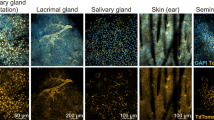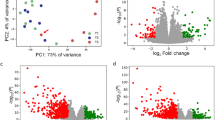Abstract
In mammals, milk provision is crucial to offspring survival and growth from birth to weaning. Milk deficiency early in life may cause death or changes in the progeny metabolism that later may lead to obesity and metabolic disorders. This study investigates milk ejection (ME) the first day after birth (D1) in F2 females from the intercross of LG/J and SM/J inbred mice strains. The absence of milk in F3 pups’ stomach at D1 is directly associated with their survival (p < 0.001) and growth pattern (p < 0.001) in the early stages of life. Furthermore, late growth pattern is also affected by this lack of nutrients at D1 because pups that survive this absence, mostly males, are heavier at weaning (p < 0.001) which, after necropsy, is shown to be due to significant higher total fat deposition (p < 0.01). We performed QTL analysis for ME at D1 in these F2 females. Maternal performance of ME revealed a complex genetic architecture which even though it contains only a single QTL (accounting for 8 % of the variation in ME), it is totally context-dependent on the genetic background. We discovered many regions involved in epistatic interactions that together with the single QTL explain 19 % of the genetic variation for this trait. Milk ejection is an important component of maternal care, and understanding the mechanisms modulating its variation, along with other maternal features, may help to disentangle the complexity that is the mother/offspring relationship.




Similar content being viewed by others
References
Barnes SK, Ozanne SE (2011) Pathways linking the early environment to long-term health and lifespan. Prog Biophys Mol Biol 106(1):323–336
Bergvall N, Iliadou A, Johansson S, de Faire U, Kramer MS, Pawitan Y, Pedersen NL, Lichtenstein P, Cnattingius S (2007) Genetic and shared environmental factors do not confound the association between birth weight and hypertension: a study among Swedish twins. Circulation 115:2931–2938
Bo S, Cavallo-Perin P, Scaglione L, Ciccone G, Pagano G (2000) Low birth weight and metabolic abnormalities in twins with increased susceptibility to Type 2 diabetes. Diabetic Med 17:365–370
Brown JR, Ye H, Bronson RT, Dikkes P, Greenberg MD (1996) A defect in nurturing in mice lacking the immediate early gene fosB. Cell 86:297–309
Carlborg O, Haley C (2004) Epistasis: too often neglected in complex trait studies? Nat Rev Genet 5:618–625
Cheverud JM (2001) A simple correction for multiple comparisons in interval mapping genome scans. Heredity 87:52–58
Cheverud JM, Routman EJ, Duarte FAM, van Swinderen B, Cothran K, Perel C (1996) Quantitative trait loci for murine growth. Genetics 142:1305–1319
Cheverud JM, Vaughn TT, Pletscher LS, Peripato AC, Adams ES, Erikson CF, King-Ellison KJ (2001) Genetic architecture of adiposity in the cross of LG/J and SM/J inbred mice. Mamm Genome 12:3–12
Chiavegatto S, Sauce B, Ambar G, Cheverud JM, Peripato AC (2012) Hypothalamic expression of Peg3 gene is associated with maternal care differences between SM/J and LG/J mouse strains. Brain Behav 2(4):365–376
Cockerham CC (1954) An extension of the concept of partitioning hereditary variance for analysis of covariances among relatives when epistasis is present. Genetics 39:859–882
Cockerham CC, Zeng ZB (1996) Design III with marker loci. Genetics 143:1437–1456
Cunningham ET, Sawchenko PE (1991) Reflex control of magnocellular vasopressin and oxytocin secretion. Trends Neurosci 14:406–411
Davidowa H, Li Y, Plagemann A (2003) Altered responses to orexigenic (AGRP, MCH) and anorexigenic (alpha-MSH, CART) neuropeptides of paraventricular hypothalamic neurons in early postnatally overfed rats. Eur J Neurosci 18:613–621
Dietrich W, Katz H, Lincoln S, Shin H-S, Friedman J, Dracopoli N, Lander ES (1992) A genetic map of the mouse suitable for typing intraspecific crosses. Genetics 131:423–447
Dyball RE, Leng G (1986) Regulation of the milk ejection reflex in the rat. J Physiol 380:239–256
Ehrich TH, Hrbek T, Kenney-Hunt JP, Pletscher LS, Wang B, Semenkovich CF, Cheverud JM (2005) Fine-mapping gene-by-diet interactions on chromosome 13 in a LG/J SM/J murine model of obesity. Diabetes 54:1863–1872
Erickson D (2005) Mapping the future of QTL’s. Heredity 95:417–418
Falconer DS, Mackay TFC (1996) Introduction to quantitative genetics. Longman Press, New York
Forsyth IA (1996) The insulin-like growth factor and epidermal growth factor families in mammary cell growth in ruminants: action and interaction with hormones. J Dairy Sci 79:1085–1096
Garofano A, Czernichow P, Breant B (1999) Effect of ageing on beta-cell mass and function in rats malnourished during the perinatal period. Diabetologia 42:711–718
Gjorevski N, Nelson CM (2011) Integrated morphodynamic signalling of the mammary gland. Nat Rev Mol Cell Biol 12:581–593
Goodale (1938) A study of the inheritance of body weight in the albino mouse by selection. J Hered 29:101–112
Hales CN, Barker DJ (1992) Type 2 (non-insulin-dependent) diabetes mellitus: the thrifty phenotype hypothesis. Diabetologia 35:595–601
Hales CN, Barker DJP (2001) The thrifty phenotype hypothesis. Br Med Bull 60:5–20
Haley CS, Knott SA (1992) A simple regression method for mapping quantitative trait loci in line crosses using flanking markers. Heredity 69:315–324
Hrbek T, de Brito RA, Wang B, Pletscher LS, Cheverud JM (2006) Genetic characterization of a new set of recombinant inbred lines (LGXSM) formed from the intercross of SM/J and LG/J inbred mouse strains. Mamm Genome 17:417–429
Kao CH, Zeng ZB (2002) Modeling epistasis of quantitative trait loci using Cockerham’s model. Genetics 160:1243–1261
Kramer M, Vaughn TT, Pletscher LS, King-Ellison K, Adams E, Erikson C, Cheverud JM (1998) Genetic variation for body weight gain and composition in the intecross of large (LG/J) and small (SM/J) inbred strains of mice. Genet Mol Biol 21:211–218
Krasnegor NA, Bridges RS (1989) Mammalian parenting biochemical, neurobiological, and behavioral determinants. Oxford University Press, New York
Kuroda KO, Tachikawa K, Yoshida S, Tsuneoka Y, Numan M (2011) Neuromolecular basis of parental behavior in laboratory mice and rats: With special emphasis on technical issues of using mouse genetics. Prog Neuropsychopharmacol Biol Psychiatry 35:1205–1231
Lamote I, Meyer E, Massart-Leën AM, Burvenich C (2004) Sex steroids and growth factors in the regulation of mammary gland proliferation, differentiation, and involution. Steroids 69:145–159
Lander ES, Botstein D (1989) Mapping Mendelian factors underlying quantitative traits using RFLP linkage maps. Genetics 121:185–199
Lee PC, Majluf P, Gordon IJ (1991) Growth, weaning and maternal investment from a comparative perspective. J Zool 225:99–114
Li J, Ji L (2005) Adjusting multiple testing in multilocus analyses using the eigenvalues of a correlation matrix. Heredity 95:221–227
Li LL, Keverne EB, Aparicio SA, Ishino F, Barton SC, Surani MA (1999) Regulation of maternal behavior and offspring growth by paternally expressed Peg3. Science 284:330–333
Liu X, Robinson GW, Wagner K, Garrett L, Wynshaw-Boris A, Hennighausen L (1997) Stat5a is mandatory for adult mammary gland development and lactogenesis. Genes Dev 11:179–186
Lynch M, Walsh B (1998) Genetics and analysis of quantitative traits. Sinauer Associates, Sunderland
MacArthur J (1944) Genetics of body size and related characters. I. Selection of small and large races of the laboratory mouse. Am Nat 78:142–157
Manly KF, Cudmore RH Jr, Meer JM (2001) Map Manager QTX, cross-platform software for genetic mapping. Mamm Genome 12:930–932
McLean JA, Speakman JR (1997) Non-nutritional maternal support in the brown long-eared bat. Anim Behav 54:1193–1204
Meaney MJ, Szyf M, Seckl JR (2007) Epigenetic mechanisms of perinatal programming of hypothalamic-pituitary-adrenal function and health. Trends Mol Med 13:269–277
Merilä J, Sheldon BC (1999) Genetic architecture of fitness and nonfitness traits: empirical patterns and development of ideas. Heredity 83:103–109
Modi N, Thomas EL, Harrington TA, Uthaya S, Dore CJ, Bell JD (2006) Determinants of adiposity during preweaning postnatal growth in appropriately grown and growth-restricted infants. Pediatr Res 60:345–348
Nelson JE, Krawetz SA (1992) Purification of cloned and genomic DNA by guanidine thiocyanate/isobutyl alcohol fractionation. Anal Biochem 207:197–201
Neville MC, McFadden TB, Forsyth I (2002) Hormonal regulation of mammary differentiation and milk secretion. J Mammary Gland Biol Neoplasia 7:49–66
Noguera JC, Lores M, Alonso-Alvarez C, Velando A (2011) Thrifty development: early-life diet restriction reduces oxidative damage during later growth. Funct Ecol 25:1144–1153
Norgard EA, Roseman CC, Fawcett GL, Pavlicev M, Morgan CD, Pletscher LS, Wang B, Cheverud JM (2008) Identification of quantitative trait loci affecting murine long bone length in a two-generation intercross of LG/J and SM/J Mice. J Bone Miner Res 23:887–895
Nwagwu MO, Cook A, Langley-Evans SC (2000) Evidence of progressive deterioration of renal function in rats exposed to a maternal low-protein diet in utero. Br J Nutr 83:79–85
Ormandy CJ, Binart N, Kelly PA (1997) Mammary gland development in prolactin receptor knockout mice. J Mammary Gland Biol Neoplasia 2:355–364
Palmer CA, Neville MC, Anderson SM, McManaman JL (2006) Analysis of lactation defects in transgenic mice. J Mammary Gland Biol Neoplasia 11:269–282
Peripato AC, Cheverud JM (2002) Genetic influences on maternal care. Am Nat 160:173–185
Peripato AC, de Brito RA, Vaughn TT, Pletscher LS, Matioli SR, Cheverud JM (2002) Quantitative trait loci for maternal performance for offspring survival in mice. 162:1341–1362
Peripato AC, de Brito RA, Matioli SR, Pletscher LS, Vaughn TT, Cheverud JM (2004) Epistasis affecting litter size in mice. J Evol Biol 17:593–602
Plath A, Einspanier R, Peters F, Sinowatz F, Schams D (1997) Expression of transforming growth factors alpha and beta-1 messenger RNA in the bovine mammary gland during different stages of development and lactation. J Endocrinol 155:501–511
Poulsen P, Vaag A, Kyvik K, Moller-Jensen D, Beck-Nielsen H (1997) Low birth weight is associated with NIDDM in discordant monozygotic and dizygotic twin pairs. Diabetologia 40:439–446
Routman EJ, Cheverud JM (1994) A rapid method of scoring simple sequence repeat polymorphisms with agarose gel electrophoresis. Mamm Genome 5:187–188
Samocha KE, Lim JE, Cheng R, Sokoloff G, Palmer AA (2010) Fine mapping of QTL for prepulse inhibition in LG/J and SM/J mice using F2 and advanced intercross lines. Genes Brain Behav 9:759–767
Sauce B, de Brito RA, Peripato AC (2012) Genetic architecture of nest building in mice LG/J x SM/J. Front Genet 3:90
Silver LM (1995) Mouse genetics concepts and applications. Oxford University Press, New York
Svennersten-Sjaunja K, Olsson K (2005) Endocrinology of milk production. Domest Anim Endocrinol 29:241–258
Vaughn TT, Pletscher LS, Peripato A, King-Ellison K, Adams E, Erikson C, Cheverud JM (1999) Mapping quantitative trait loci for murine growth: a closer look at genetic architecture. Genet Res 74:313–322
Warner MJ, Ozanne SE (2010) Mechanisms involved in the developmental programming of adulthood disease. Biochem J 427:333–347
Wolf JB, Brodie ED III, Wade MJ (2000) Epistasis and the evolutionary process. Oxford University Press, New York
Wolf JB, Vaughn TT, Pletscher LS, Cheverud JM (2002) Contribution of maternal effect QTL to genetic architecture of early growth in mice. Heredity 89:300–310
Wolf JB, Leamy LJ, Roseman CC, Cheverud JM (2011) Disentangling prenatal and postnatal maternal genetic effects reveals persistent prenatal effects on offspring growth. Genetics 189:1069–1082
Wright CM, Parkinson KN (2004) Postnatal weight loss in term infants: what is “normal” and do growth charts allow for it? Arch Dis Child Fetal Neonatal Ed 89:F254–F257
Yamamuro Y, Sensui N (1998) Exogenous oxytocin attenuates suckling-induced prolactin release but not maternal or infant behavior in lactating rats. Physiol Behav 63:939–943
Acknowledgments
We thank Reinaldo A. de Brito and Iderval S. Sobrinho for their comments. This study was supported by Grants from the Sao Paulo State Foundation for Research Support (FAPESP: 04/14583-9 and 05/56353-2 to ACP). CPG and BS were recipients of FAPESP Undergraduate and Master’s fellowships, respectively.
Author information
Authors and Affiliations
Corresponding author
Rights and permissions
About this article
Cite this article
Góes, C.P., Sauce, B. & Peripato, A.C. Milk ejection in mice LG/J x SM/J. Mamm Genome 23, 770–779 (2012). https://doi.org/10.1007/s00335-012-9431-1
Received:
Accepted:
Published:
Issue Date:
DOI: https://doi.org/10.1007/s00335-012-9431-1




